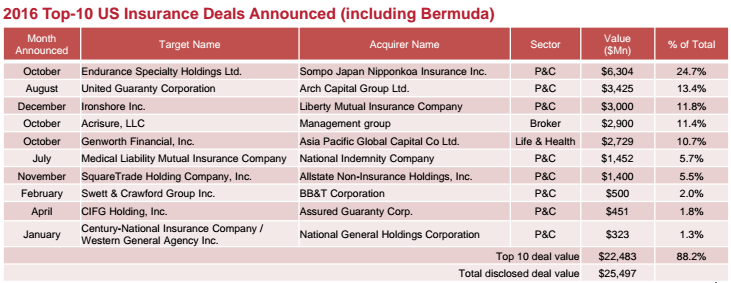Mergers and acquisitions in the insurance sector continued to be very active in 2016 on the heels of record activity in 2015. There were 482 announced transactions in the sector for a total disclosed deal value of $25.5 billion. Deal activity was driven by Asian buyers eager to diversify and enter the U.S. market, by divestitures and by insurance companies looking to expand into technology, asset management and ancillary businesses.
We expect the strong M&A interest to continue, driven primarily by inbound investment.
With the election of a new president and the transition of power in January 2017 comes tax and regulatory uncertainty, which may temporarily decelerate the pace of deal activity. President Trump is expected to prioritize the repeal and replacement of Obamacare, tax reform and changes to U.S. trade policy, all of which have unique and potentially significant impact on the insurance sector. Further, the latest Chinese inbound deals have drawn regulatory scrutiny, with skepticism from the stock market regarding their ability to obtain regulatory approval.
Bond yields have spiked over the last few months and are widely expected to continue to increase. The increase in yields should improve insurance company earnings, which is likely to encourage sales of legacy and closed blocks.
 Highlights of 2016 deal activity
Insurance activity remains high
Highlights of 2016 deal activity
Insurance activity remains high
Insurance deal activity has steadily increased since the financial crisis, reaching records in 2015 both in terms of deal volume and announced deal value. While M&A declined in 2016, activity remained high, with announced deals and deal values exceeding the levels seen in 2014. In 2015, deal value was driven by the Ace-Chubb merger, valued at $29.4 billion, which accounted for 41% of deal value.
See also: A Closer Look at the Future of Insurance
Significant transactions
Key themes in 2016 include:
- Continued consolidation of Bermuda insurers, with the acquisitions of Allied World, Endurance and Ironshore. Drivers of consolidation include the difficult growth and premium environment.
- Interest by Asian insurers in continuing to expand their U.S. footprint -- accounting for two of the top-10 transactions.
- Expansion in specialty lines of business as core businesses have become more competitive. This is evidenced by (i) Arch’s acquisition of mortgage insurer United Guaranty as a third major business after P&C reinsurance and P&C insurance; (ii) Allstate’s acquisition of consumer electronics and appliance protection plan provider SquareTrade to build out its consumer-focused strategy; and (iii) the agreement by National Indemnity (subsidiary of Berkshire Hathaway) to acquire the largest New York medical professional liability provider, Medical Liability Mutual Insurance, a deal expected to close in 2017.
- More activity in insurance brokerage, which accounts for two of the top-10 deals.
- Focus on scaling up to generate synergies, as evidenced by the acquisitions done by Assured Guaranty and National General Holdings.
- Continued growth in asset management capabilities, as exemplified by New York Life Investment Management's expanding its alternative offerings by announcing a majority stake in Credit Value Partners LP in January 2017 and MassMutual's acquiring ACRE Capital Holdings, a specialty finance company engaged in mortgage banking.
 Key trends and insights
Sub-sectors highlights
Life & Annuity
Key trends and insights
Sub-sectors highlights
Life & Annuity – The sector has been affected by factors such as Asian buyers diversifying their revenue base, regulations such as the fiduciary rule by the Department of Labor and the SIFI designation, divestitures and disposing of underperforming legacy blocks, specifically variable annuity and long term care businesses.
P&C – The sector has been experiencing a challenging pricing cycle, which has driven insurers to 1) focus on specialty lines and specialized niche areas for growth and 2) consolidate. We have seen large insurance carriers enter the specialty space. Furthermore, with an abundance of capacity and capital, the dynamics of the reinsurance market have changed. Reinsurers are trying to adjust to the new reality by turning to M&A and innovation in products and markets.
Insurance Brokers – The insurance brokerage space has seen a wave of consolidation given the current low-interest-rate environment, which translates into cheap debt. The next consolidation wave is likely in managing general agents, as they are built on flexible and innovative foundations that set them apart from traditional underwriting businesses.
See also: Key Findings on the Insurance Industry
Insurtech has grown exponentially since 2011. According to PwC’s 2016 Global FinTech Survey, 21% of insurance business is at risk of being lost to standalone fintech companies within five years. As such, insurers have set up their own venture capital arms, typically investing at the seed stage, in efforts to keep up with the pace of technology and innovation and find ways to enhance their core business. Investments by insurers and their corporate venture arms are on pace to rise nearly 20x from 2013 to 2016 at the current run rate.
Conclusion and outlook
The insurance industry will be affected by the proposed policies of the Trump administration, especially on tax and regulatory issues. Increasing bond yields and the Fed’s latest signal about a quick pace of rate increases in 2017 are expected to improve portfolio income for insurers.
- Macroeconomic environment: U.S. equity markets have been rallying since the election, with optimism supported by President Trump’s policies to boost growth and relieve regulatory pressures. However, the rally may be short-lived if policies fail to meet investor expectations. While the Fed is widely expected to raise rates in 2017, other central banks around the world are easing, and uncertainty in Europe has spread, with the possibility that countries will leave the euro zone or the currency union will break apart.
- Regulatory environment: The direction of regulatory and tax policy is likely to change materially, as the president has campaigned for deregulation and reducing taxes. Uncertainty around the DOL fiduciary rule has been mounting even though President Trump has not spoken out on the rule; some of his advisers have said they intend to roll it back. His proposed changes to Obamacare will affect life insurers, but at this juncture it is hard to estimate the extent of the impact given the lack of specifics shared by the new administration.
- Sale of legacy blocks: Continued focus on exiting legacy risks such as A&E, long-term care and VA by way of sale or reinsurance. In 2017, already, there have been two significant announced transactions, AIG paying $10 billion to Berkshire for long-tail liability exposure and Hartford paying National Indemnity $650 million for adverse development cover for A&E losses.
- Expansion of products: Insurers will focus on expanding into niche areas such as cyber insurance (expected to be the fastest-growing insurance product fueled by a slate of recent corporate and government hacking). Further, life insurers are focusing on direct-issue term products.
- Technology: Emerging technologies including automation, robo-advisers, data analysis and blockchain are expected to transform the insurance industry. Incumbents have been responding by direct investment in startups or forming joint ventures to stay competitive and will continue to do so.
- Foreign entrants: Chinese and Japanese insurers have keen interest in expanding due to weak domestic economies, intent to diversify products and risk and hope to expand capabilities.
- Private equity/hedge funds/family offices: Non-traditional firms have a strong interest in expanding beyond the brokers and annuities business to include other sectors within insurance, such as MGAs.
 Highlights of 2016 deal activity
Insurance activity remains high
Insurance deal activity has steadily increased since the financial crisis, reaching records in 2015 both in terms of deal volume and announced deal value. While M&A declined in 2016, activity remained high, with announced deals and deal values exceeding the levels seen in 2014. In 2015, deal value was driven by the Ace-Chubb merger, valued at $29.4 billion, which accounted for 41% of deal value.
See also: A Closer Look at the Future of Insurance
Significant transactions
Key themes in 2016 include:
Highlights of 2016 deal activity
Insurance activity remains high
Insurance deal activity has steadily increased since the financial crisis, reaching records in 2015 both in terms of deal volume and announced deal value. While M&A declined in 2016, activity remained high, with announced deals and deal values exceeding the levels seen in 2014. In 2015, deal value was driven by the Ace-Chubb merger, valued at $29.4 billion, which accounted for 41% of deal value.
See also: A Closer Look at the Future of Insurance
Significant transactions
Key themes in 2016 include:
 Key trends and insights
Sub-sectors highlights
Life & Annuity – The sector has been affected by factors such as Asian buyers diversifying their revenue base, regulations such as the fiduciary rule by the Department of Labor and the SIFI designation, divestitures and disposing of underperforming legacy blocks, specifically variable annuity and long term care businesses.
P&C – The sector has been experiencing a challenging pricing cycle, which has driven insurers to 1) focus on specialty lines and specialized niche areas for growth and 2) consolidate. We have seen large insurance carriers enter the specialty space. Furthermore, with an abundance of capacity and capital, the dynamics of the reinsurance market have changed. Reinsurers are trying to adjust to the new reality by turning to M&A and innovation in products and markets.
Insurance Brokers – The insurance brokerage space has seen a wave of consolidation given the current low-interest-rate environment, which translates into cheap debt. The next consolidation wave is likely in managing general agents, as they are built on flexible and innovative foundations that set them apart from traditional underwriting businesses.
See also: Key Findings on the Insurance Industry
Insurtech has grown exponentially since 2011. According to PwC’s 2016 Global FinTech Survey, 21% of insurance business is at risk of being lost to standalone fintech companies within five years. As such, insurers have set up their own venture capital arms, typically investing at the seed stage, in efforts to keep up with the pace of technology and innovation and find ways to enhance their core business. Investments by insurers and their corporate venture arms are on pace to rise nearly 20x from 2013 to 2016 at the current run rate.
Conclusion and outlook
The insurance industry will be affected by the proposed policies of the Trump administration, especially on tax and regulatory issues. Increasing bond yields and the Fed’s latest signal about a quick pace of rate increases in 2017 are expected to improve portfolio income for insurers.
Key trends and insights
Sub-sectors highlights
Life & Annuity – The sector has been affected by factors such as Asian buyers diversifying their revenue base, regulations such as the fiduciary rule by the Department of Labor and the SIFI designation, divestitures and disposing of underperforming legacy blocks, specifically variable annuity and long term care businesses.
P&C – The sector has been experiencing a challenging pricing cycle, which has driven insurers to 1) focus on specialty lines and specialized niche areas for growth and 2) consolidate. We have seen large insurance carriers enter the specialty space. Furthermore, with an abundance of capacity and capital, the dynamics of the reinsurance market have changed. Reinsurers are trying to adjust to the new reality by turning to M&A and innovation in products and markets.
Insurance Brokers – The insurance brokerage space has seen a wave of consolidation given the current low-interest-rate environment, which translates into cheap debt. The next consolidation wave is likely in managing general agents, as they are built on flexible and innovative foundations that set them apart from traditional underwriting businesses.
See also: Key Findings on the Insurance Industry
Insurtech has grown exponentially since 2011. According to PwC’s 2016 Global FinTech Survey, 21% of insurance business is at risk of being lost to standalone fintech companies within five years. As such, insurers have set up their own venture capital arms, typically investing at the seed stage, in efforts to keep up with the pace of technology and innovation and find ways to enhance their core business. Investments by insurers and their corporate venture arms are on pace to rise nearly 20x from 2013 to 2016 at the current run rate.
Conclusion and outlook
The insurance industry will be affected by the proposed policies of the Trump administration, especially on tax and regulatory issues. Increasing bond yields and the Fed’s latest signal about a quick pace of rate increases in 2017 are expected to improve portfolio income for insurers.








